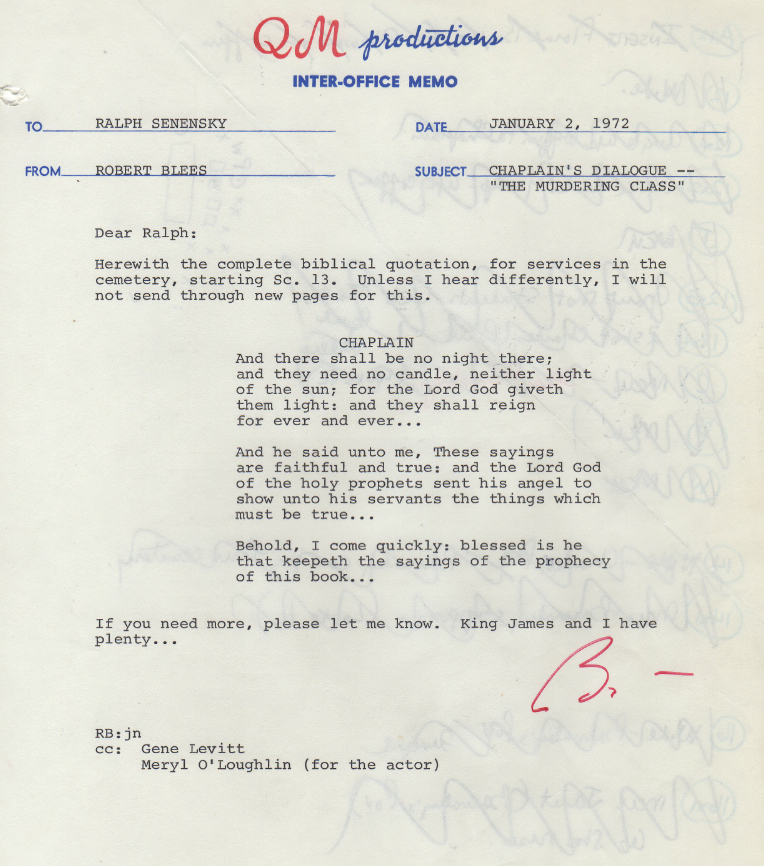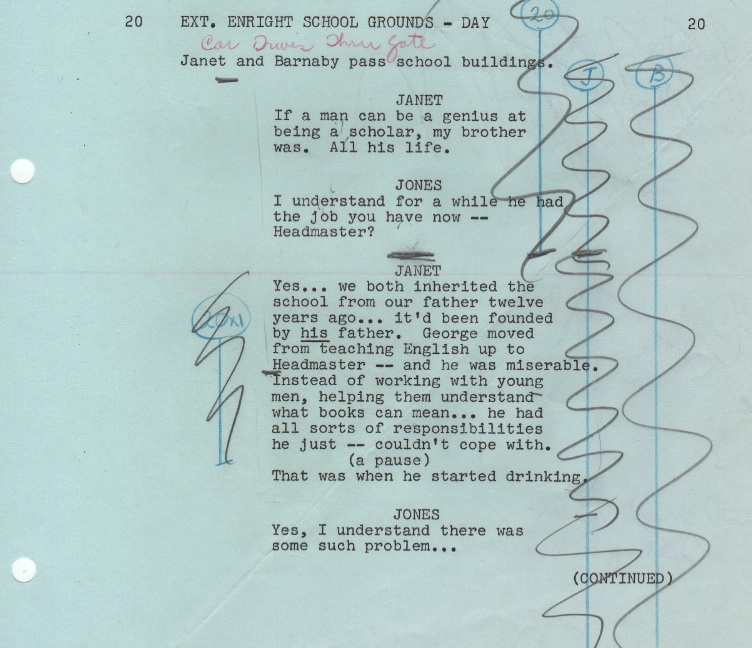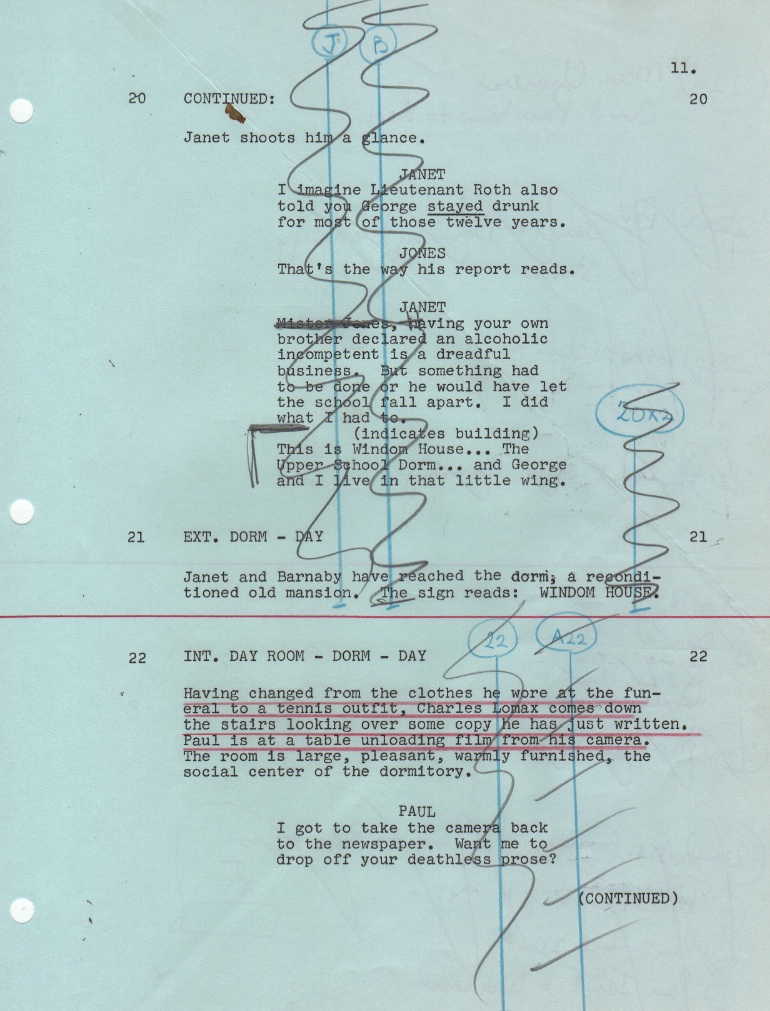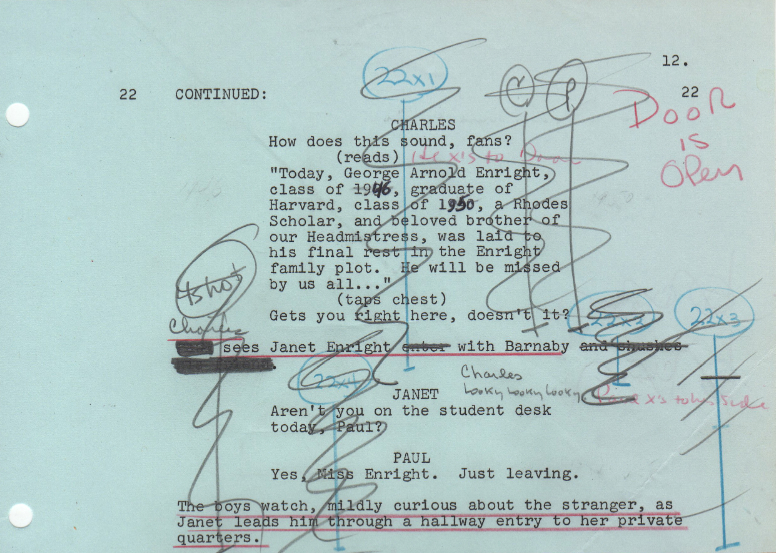FILMED January 1973
As I wended my way back into hour-long shows after the debacle of THE THOLIAN WEB, my major employment was in shows of crime, and I think that was because crime shows had become the programs of choice at the networks. It eventually reached the time when if the networks had a major star in a retiring series, they returned him to the airwaves as a crime solver: David Janssen in HARRY O, James Garner in THE ROCKFORD FILES, Andy Griffith in MATLOCK, Dick Van Dyke in DIAGNOSIS MURDER; and some of them even as detectives of advanced years in age. Possibly the earliest (and oldest) of these returnees was Buddy Ebsen as BARNABY JONES.
BARNABY JONES was a midseason replacement, first air date January 28, 1973. THE MURDERING CLASS was the fourth show to air during that first short season. The series was an immediate success and remained on CBS for seven more seasons, making it I think the second longest running series for QM Productions, surpassed only by THE FBI which ran nine seasons. An interesting side note: John Carter, who played George, the murdered man just rolled down the hillside, returned at the beginning of the second season as a new character, Police Lt. John Biddle, and appeared in ninety-four more episodes of the series.
Our first day of location filming was at the Odd Fellows Cemetery in East Los Angeles. The screenplay writer had provided just a few lines for the Chaplain’s service. Anticipating that I would need more words, Executive Story Consultant Robert Blees sent me an inter-office memo …

…which was fortuitous; I did indeed need more words for the Chaplain, who was played by John Graham, an actor who had appeared in my 1960 Equity Library Theatre production of MORNING’S AT SEVEN, the production that propelled me into film directing. You can read about that in my post of JOHNNY TEMPLE on DR. KILDARE.
People today are usually amazed that these productions were filmed in six or seven days. What they don’t realize is that even more was filmed than they have viewed. There were two scenes that occurred after the cemetery sequence that were filmed, but because of the time restriction had to be eliminated in the final editing.



George’s book-lined office was NOT a set on a soundstage at the studio. It was a ready-made live location. For this production the usual QM schedule of four days location filming and three days studio soundstage filming was changed to five days out and two days in. The script, in addition to the school exteriors, called for so many school interior sets, it was more practical to film many of those interiors live at wherever we picked for the school rather than build them at the studio. The location selected for filming our boys’ school was the Villa Cabrini in Burbank, an establishment with a history worthy of having its story filmed. It was founded as a preventorium, a clean and safe environment for girls to study, by Mother Frances Cabrini, the first United States citizen to achieve sainthood. In 1933, the preventorium became the Villa Cabrini Academy high school. The academy closed in 1971, and with no students filling the corridors and with a beautiful campus for our exteriors it provided an ideal site for our location filming.
It had been a year and a half since I first worked with Jerry Houser in THE GAME OF TERROR on THE FBI, which was only his second film appearance. As I think I’ve made clear, I am very interested in the craft of acting. I like to trace the growth and development in actors, past and present, by studying their performances from their starts and through the years. Starting in the fifties there was a tidal wave of young James Dean emulators. How refreshing it had been when novice Jerry Houser had appeared in THE FBI episode, where he had created a real character based on his own persona. It was gratifying to see the growth in Jerry in the short time since — no longer a novice, already a seasoned professional.
Andrew Parks was another Hollywood prince, the son of two illustrious talents, Larry Parks and Betty Garrett. His mother had come from Broadway to an MGM contract, where she appeared in many of their big musicals. His father, put under contract by Columbia Studio in 1941, spent five years before he broke through big time with an Academy Award nominated performance as Al Jolson in THE JOLSON STORY. Both careers were on an impressive upswing, but in the early fifties both careers came to a halting stop. Because of their past affiliations with the Communist Party they were summoned to appear before Joseph McCarthy’s House Un-American Activities Committee. Betty Garrett could not appear, because she was pregnant with Andrew. Larry Parks did appear and testified that he had belonged to a Communist cell from 1941 to 1945. He tearfully cooperated with the Committee, but he was the first Hollywood celebrity to come forth with a confession, and the political scandal that erupted brought about the cancellation of his contract with Columbia Studio. The two returned to the theatre, and Betty Garrett was later productively employed in television. Larry Parks died two years after we filmed THE MURDERING CLASS. I had not seen Andrew in the interim, but I attended the moving memorial service that was held for his father at the Mark Taper Forum in Los Angeles.
There were three sequences to film on our location day at the cemetery, one of them night. We started filming the show on a Friday, so the cemetery location was scheduled for that day to take advantage of the turnaround that the weekend provided for the actors’ calls.
Because of Buddy’s age, scripts for BARNABY JONES were different than the scripts for the other QM show I had directed. No actions sequences like the ones I had staged for THE FBI; no stunts for Barnaby like the ones performed by Burt Reynolds’ DAN AUGUST. The scripts were more cerebral, involved with the minutiae of the case, similar to the old PERRY MASON series.
This was the second and last time I would work with Geraldine Brooks. A decade before she had appeared in the first color film I directed, A HERO FOR OUR TIME on SUSPENSE THEATRE. I had been a big fan since her appearance in her second film, the 1947 Joan Crawford starrer, POSSESSED. Interestingly her real name was not Brooks. She was Geraldine Strook, but took the better marquee name of Brooks, the name of New York City’s most famous theatrical costume house, owned by her father.
They don’t make performers like Buddy Ebsen any more. He could dance, he could sing, he could act comedy or drama; he appeared in vaudeville, on Broadway, in the movies and on television. His seven decades long career started when, like Fred Astaire, he paired with his sister Vilma as a dance team; in fact they were known as “The Baby Astaires.” He made his film debut in MGM’s BROADWAY MELODY OF 1936. He danced with Shirley Temple in CAPTAIN JANUARY and with Judy Garland in BROADWAY MELODY OF 1938. Buddy was cast as the Scarecrow in MGM’s THE WIZARD OF OZ. Hollywood lore has it that Ray Bolger, cast as the Tin Man, convinced Buddy that they should swap roles. Buddy went through all the rehearsals and began filming, but he soon began experiencing cramps and shortness of breath, eventually leading to hospitalization. Doctors determined that he was suffering an allergic reaction to the aluminum dust used in the Tin Man makeup. Buddy was forced to leave the production for health reasons. He was replaced by Jack Haley, the aluminum dust makeup was replaced by a paste, and Buddy missed becoming a part of the legendary foursome that danced down the yellow brick road.
But by the time Buddy became BARNABY JONES, he was a television legend having played Jed Clampett for nine seasons on THE BEVERLY HILLBILLIES.
By 1973 scripting in television had changed. BARNABY JONES, because of the high standard of production by the Quinn Martin organization, was one of the quality series on the air. But I thought the scripts, although they were professionally written and were very entertaining, were slick and glib, lacking the depth, the sense of importance, the dealing with a true humanity that had infused NAKED CITY, ROUTE 66, BREAKING POINT. What I didn’t know then was that over the hill on the sound stages of Burbank, a new series was filming that would bring back those qualities for me in my work in just half a year – THE WALTONS.
The Journey Continues



Ralph, another great post. You mention the character actor John Graham as the Chaplain… he seems to have disappeared without a trace, even the IMDB doesn’t have any dates on him (they also seem to confuse him with a lot of other John Grahams). Do you know whatever became of him?
No, I’m sorry to say I don’t know. That was one of the things about this profession — how solid relationships could be and yet how how time managed to slip in so that one never really knew when one said goodbye to a friend, it might be for the last time.
The opening credits of each Quinn Martin show always stood out. Although I still have mixed feelings towards the series “Barnaby Jones”, the opening, especially Jerry Goldsmith’s theme, always hooked me into watching an episode.
In addition, were directors required to shoot extra footage (reaction shots?) for the shows’ ‘guest star’ credits and who was usually responsible for editing the opening credits?
The “reaction shots” used for the show’s guest star credits were clips extracted from footage in the show’s filming. I’m not sure who selected them, but my guess would be the editor for the episode. Many times I can recognize the close-up and know which scene it was taken from. And it was the editor who constructed the opening billboard including those introductory credits.
Since you mentioned Jerry Goldsmith, I have to add this. I knew Jerry, but not well, back in the fifties when I was on staff of Playhouse 90, and Jerry composed the background music for the live broadcast. For a composer on a film, it is a daunting task. He looks at the film, decides the places where he feels music should be added, times the length of each portion of film, denoting the musical changes he will do to match the action on the film and then composes the music which he will later conduct when it is recorded. I was in awe of what he did on Playhouse 90. He did not have a final performance for which he would be composing. He observed the play in rehearsal in the rehearsal hall, selecting where he felt music should be added, but unlike film, where the composer was able to match his music to the action in the scene, the timing in the live performance scene could change from rehearsal to rehearsal to final performance. Jerry composed his background score, and then during the live broadcast he was in a room with his group of musicians, far removed from Stage 30 where the play was being performed, and conducted a live performance of his musicians with a set of headphones and a television monitor showing him the picture being transmitted. If composing background music for a film was a daunting task, doing it for a live television show was impossible — but he did it brilliantly.
Totally agree about Jerry Goldsmith. A true musical genius.
There were some terrific composers of film and television music — Bernard Herrmann, Fred Steiner, John Barry, for example. But, in my opinion, Jerry Goldsmith was a cut above the rest.
I can usually identify the composer after listening to a few bars of music. “Ah, that sounds like a John Barry score — he always goes for that particular sound from his trumpets.”
The thing that made Jerry Goldsmith a super-genius is that he was like a chameleon. He didn’t have an identifiable ‘pattern’ to his compositions. You can’t listen to a piece of his music and say, “Ah, that’s Jerry Goldsmith.” He could compose in any genre, and do it well.
We were lucky to have had him for as long as we did.
Another great post, thank you Ralph. I’ve what may be a silly question, but I’ll ask anyway — I had the occasion to visit the set, I don’t recall why — but I do recall watching an amazing piece of magic — Buddy had a pan of ice water with a towel in it set before him — just before the camera rolled (or it might have been rolling) Buddy applied the ice water-soaked towel to his face, held it in place for a few seconds, lowered it and immediately began his performance. He looks great in your show — do you recall him doing this?
I don’t remember that John, but thank you for presenting it. It’s an interesting bit of trivia.I’m sure now that the reason for doing it was that the cold water would tighten the skin, and I guess it worked.
I learned something new from Ralph again. I knew who Larry Parks and Betty Garrett were, but I didn’t know they were married and had a son who went into acting.
Poor Jerry Houser – first in ‘The FBI’ and now in ‘Barnaby Jones’, he’s getting dragged down by his sociopathic best friend! He needs to man-up! It had slipped my mind that he also played Dave (Killer) Carlson in ‘Slap Shot’.
Good ol’ Booth Colman…if a role calls for a bureaucratic killjoy, he’s perfect! That guy was in almost every series. Anyone notice the cemetery gardener? It’s Charles Wagenheim, who did bit parts in a ton of movies and TV shows. He’s got a distinctive voice you don’t forget.
Finally, I looked up James Daughton, who played the shaggy friend of Parks and Houser. This guy slipped past me too…give him a buzz cut and he’s rotten Greg Marmalad from ‘Animal House’.
You can get another look at James Daughton on THE TYRANT on PLANET OF THE APES.
Regarding Jerry Goldsmith’s theme for BARNABY JONES, someone has uploaded a 13-minute mix of Barnaby Jones music to YouTube. I really enjoyed it. Listen for yourself.
http://www.youtube.com/watch?v=YXWEriYE5wg
Nice villany from Andrew Parks. His final speech of “poor me” was classic! He made the folks proud.Did you ever work with him again?
Do you know if he is still working? Inquiring Kathy has to know. Thanks again Ralph for these wonderful, insightful posts!
Hi Kathy: No, unfortunately I never worked with Andrew Parks again. But yes, he still is working. I checked him out on IMDB (Internet Movie Data Base). You should check him out there. There are current pictures of him and he has really changed in appearance. Attractive adult rather than cute kid.
Hi Ralph. Thanks for the tip. I checked him out, and he is still HOT! I also viewed a pictoral tribute of his parents and their boys at a party honoring his mom. It appears they had a lovely marriage in spite of their difficulties. Bravo to them!
This is an episode that I have viewed at least 40 times ever since the DVD release. It was also my first introduction to Geraldine Brooks and Andrew Parks. It was somewhat frightening to read the edited portion where Parks’ character taps on his chest before giving his line: “Gets you right here, doesn’t it?” He really establishes himself as a sociopath at this point.
I understand that Geraldine was a superb actress and took her work seriously . It shows in the very simplest of scenes – even if there are no lines. The very last shot of her climbing the school steps win a renewed vigor as she appears ready to start over again. It always leaves me with a wondering thought of what her character’ life was going to be like.
“Mrs. So-and-So told all of us on student desk duty that you no longer have permission to be on school property, Mr. Jones.”
Still remember that line from the episode’s climatic scene, as well as Barnaby’s quip, “Now….about George Emright’s coffin.”
I must say it was hard to find your page in google. You write interesting articles but you should rank your website higher
in search engines. If you don’t know how to do it
search on youtube: how to rank a website Marcel’s way
Hi, Ralph –
There was a Barnaby Jones marathon last week on ME-Tv. It’s start with Season 5 Episode 1 with the introduction of Mark Shera. It was such a good show and the theme song just grabbed you. I don’t really have a question as much as an observation. I thought it was interesting that a complete script is written and filmed to include all that was written but because of various reasons it can be edited out and still make sense. Obviously, that’s the job of an editor but is it always easy to make sense of show when scene are edited out?
Interesting question and the answer is something I learned to do in advance. I recognized early on that shooting too much so that it would have to be edited out could cause story confusion later. I remember that happening to me on the movie for tv THE FAMILY NOBODY WANTED. Most of the time I tried to get the script cut down before shooting.
Ahhhhhh! Less is more.
Yeah!!!!!!!!!
What’s with the racial comment that is bleeped out? Was it bleeped out in the original airing? Regardless, how come the writers thought that was OK for that to be part of the script, even back in 1973?
Mark: Which clip has the bleep-out? I don’t recall that happening!
It was beeped out for the home video release, not the original 1973 airing. Most older viewers would understand the context of the epithet, but it is a word that cannot be uttered today.
I’m curious. What was beeped out. It’s difficult for me to figure out that there was anything that got past the network censors that would require beeping.
It was the scene where Andrew Parks hinted they were going to frame their tennis instructor for the death of John Carter’s character. He says “We have to throw a little light on the n_____ in the woodpile” Near the end of Act I.
Thank you for the info. I’m surprised it wasn’t censored by the ABC network.
Thanks for the great story about Buddy Ebsen and the Tin Man who wasn’t. You’re right – Ebsen could do it all and probably would have been marvelous